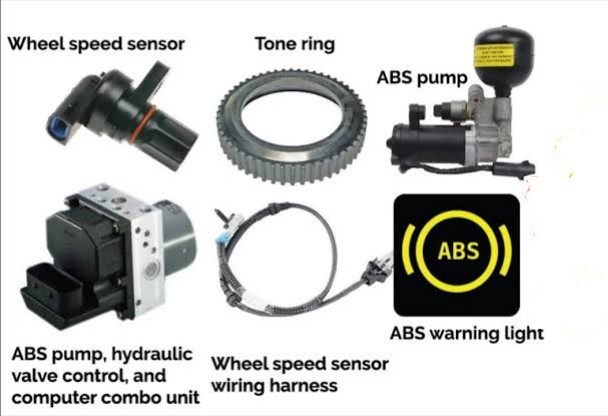The C0051 code is a diagnostic trouble code (DTC) that indicates a problem with the left front (LF) wheel speed sensor circuit. The wheel speed sensor is a device that measures the rotational speed of the wheel and sends a signal to the electronic brake control module (EBCM).
The EBCM uses this information to control the antilock braking system (ABS) and other related systems, such as traction control and stability control.
The C0051 code is set when the EBCM detects an abnormality in the signal from the LF wheel speed sensor, such as a low or high voltage, a high or low frequency, or an erratic or intermittent signal. The EBCM compares the signal from the LF wheel speed sensor with the signals from the other wheel speed sensors and the vehicle speed sensor to determine if there is a discrepancy. If the discrepancy exceeds a certain threshold, the EBCM will store the C0051 code and turn on the ABS warning light.
What are the symptoms of the C0051 code?
The most common symptom of the C0051 code is the illumination of the ABS warning light on the dashboard. Depending on the severity of the problem, the EBCM may also disable the ABS and other related systems, such as traction control and stability control. This may affect the braking performance and handling of the vehicle, especially in slippery or emergency situations.
Other possible symptoms of the C0051 code include:
- Reduced fuel efficiency
- Increased tire wear
- Erratic speedometer reading
- Poor acceleration
- Harsh or delayed shifting
What are the causes of the C0051 code?
There are many possible causes of the C0051 code, such as:
- A faulty LF wheel speed sensor
- A damaged or corroded LF wheel speed sensor wiring or connector
- A loose or missing LF wheel speed sensor mounting bolt or bracket
- A worn or damaged LF wheel bearing or hub assembly
- A cracked or damaged LF tone ring or reluctor ring
- A faulty EBCM
- A faulty vehicle speed sensor
How to diagnose and fix the C0051 code?
- To diagnose and fix the C0051 code, you will need a scan tool, a digital multimeter, and a repair manual for your vehicle. Follow these steps:
- Scan for codes. Use a scan tool to retrieve any stored codes and freeze frame data from the EBCM. Note down any other codes that may be related to the C0051 code, such as wheel speed sensor codes for other wheels, vehicle speed sensor codes, or EBCM codes.
- Clear the codes. Clear all codes from the EBCM and test drive the vehicle to see if the C0051 code returns. If it does not return, it may have been an intermittent problem that has been resolved. If it does return, proceed to the next step.
- Inspect the LF wheel speed sensor. Visually inspect the LF wheel speed sensor for any signs of damage, corrosion, looseness, or misalignment. Check that the mounting bolt or bracket is secure and tight. Check that the wiring and connector are intact and free of dirt, moisture, or debris. If you find any problems, repair or replace as needed.
- Test the LF wheel speed sensor. Disconnect the LF wheel speed sensor connector and use a digital multimeter to measure the resistance between its terminals. Compare your reading with the specifications in your repair manual. If your reading is out of range, replace the LF wheel speed sensor.
- Test the LF wheel speed sensor circuit. Reconnect the LF wheel speed sensor connector and disconnect the EBCM connector. Use a digital multimeter to measure the voltage and continuity between each terminal of the LF wheel speed sensor connector and its corresponding terminal at the EBCM connector. Compare your readings with the specifications in your repair manual. If your readings are out of range, repair or replace any faulty wiring or connectors in the circuit.
- Inspect the LF wheel bearing and hub assembly. Visually inspect the LF wheel bearing and hub assembly for any signs of wear, damage, looseness, or noise. Check that there is no excessive play or movement in the wheel when you rock it back and forth by hand. If you find any problems, replace the LF wheel bearing and hub assembly.
- Inspect the LF tone ring or reluctor ring. Visually inspect the LF tone ring or reluctor ring for any signs of cracks, damage, rust, dirt, or debris. The tone ring or reluctor ring is a metal ring with teeth that is attached to either the inside of the brake rotor or drum, or to the outside of the wheel bearing or hub assembly. The tone ring or reluctor ring rotates with the wheel and passes by the wheel speed sensor, creating an alternating magnetic field that generates the signal for the EBCM. If you find any problems, clean or replace the tone ring or reluctor ring as needed.
- Test the EBCM. Reconnect the EBCM connector and use a scan tool to monitor the live data from the LF wheel speed sensor while spinning the wheel by hand or driving the vehicle. Compare your reading with the readings from the other wheel speed sensors and the vehicle speed sensor. If your reading is erratic, inconsistent, or out of range, replace the EBCM.
- Test the vehicle speed sensor. Use a scan tool to monitor the live data from the vehicle speed sensor while driving the vehicle. Compare your reading with the speedometer reading and the readings from the wheel speed sensors. If your reading is erratic, inconsistent, or out of range, replace the vehicle speed sensor.

Comments (0)
Please login to join the discussion
Be the first to comment on this article!
Share your thoughts and start the discussion